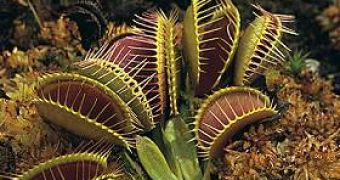The Venus flytrap (Dionaea muscicapula), inhabiting bogs in North and South Carolina (southeastern US) is a carnivorous plant, more known for catching and digesting animal prey (insects and arachnids) with a trap made by the terminal portion of each of the plant's leaves. The mechanism by which the trap shuts is based on a complex interaction between elasticity, turgor and growth.
In the open state, the two spiny lobes are convex (bent outwards), but in the closed state, the lobes are concave (forming a cavity). It is the rapid flipping of this bistable state that closes the trap.
When the trigger hairs are stimulated by the movement of a small insect, an action potential is generated, which propagates across the lobes and stimulates cells in the lobes and in the midrib between them. The trapped prey continues to stimulate the inner surface of the lobes, and this increases the response that forces the edges of the lobes together, eventually sealing the trap hermetically and forming a "stomach" in which digestion occurs, for 10 days. Then, the trap reopens, and is ready for re-use; but a trap rarely catches more than three insects in its lifetime.
Now, the trap has been investigated by a team of materials physicists, led by Alfred Crosby, at the University of Massachusetts in Amherst, for developing a new material that can quickly change its shape under the action of pressure, heat or electrical current.
The material could be applied on surfaces in order to shift their reflectivity or to switch lenses between focal lengths. The trap's movements are based on a "snap-buckling instability", a phenomenon that occurs with any rubbery hemisphere. Cut in two equal halves a tennis ball and push with your thumb a convex dome-shaped half: it will deform to the point when it turns into concave (bowl-shaped).
This is exactly what happens when a bug touches the tiny hairs (no one can say what causes the sensitivity of the hairs). "This plant can change the shape of its lobes from concave to convex at very high speeds - around 100 ms," Crosby told optics.org.
The team looked for developing a structure with the same behavior on small scales.
Circular protrusions onto a 1-mm-thick silicone layer were molded; this layer was stretched and attached to another layer of un-molded silicone below in order to achieve pockets of air. The air pockets and the rubbery material created the snap-buckling instability, that's why the protrusions could change between the convex or concave state.
This new material was stimulated by pressure, heat or an electrical current. When the protrusions shifted from convex to concave, the material's reflectivity and focal length were changed.
Such a material could be employed in outdoor signs or auto-focusing adaptive lens. Protrusions can be made in any shape or size; in the research, they varied from 50- 500 ?m in diameter and were spaced 10-50 ?m apart, with the change velocity of 30 ms or more; smaller lenses are even faster.
"[The material] could potentially be applied in arrays of on/off operating devices, such as optical switches and as actuators that control other components. The fabrication process must now be improved to produce lenses with highly uniform shapes and smoother textures," Hongrui Jiang of the University of Wisconsin, developer of a liquid lens imitating the human eye in 2006, told optics.org.

 14 DAY TRIAL //
14 DAY TRIAL //